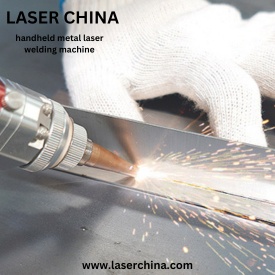In the realm of metalworking, welding stands as a cornerstone process, joining metals together seamlessly. However, traditional welding methods often entail cumbersome equipment and limited precision. Enter handheld metal laser welding machine – a game-changer revolutionizing the industry. This guide delves into the intricacies of these cutting-edge devices, exploring their functionalities, applications, benefits, and practical considerations.
Understanding Handheld Metal Laser Welding Machines: Handheld metal laser welding machines utilize concentrated beams of coherent light to join metal pieces together. Unlike traditional welding methods that rely on heat generated by an electrical arc or flame, laser welding achieves fusion through the precise application of intense energy. The compact design and portability of these devices empower welders to access tight spaces and execute intricate welds with unparalleled accuracy.
Applications: Handheld metal laser welding machines find applications across various industries, including automotive, aerospace, electronics, jewelry, and medical device manufacturing. Their versatility allows for the seamless joining of dissimilar metals, intricate components, and thin materials. From fabricating precision components to repairing delicate assemblies, these machines offer a versatile solution to diverse welding challenges.
Benefits:
- Precision: Laser welding enables precise control over heat input, minimizing distortion and ensuring superior weld quality.
- Versatility: The ability to weld a wide range of metals, including stainless steel, aluminum, titanium, and copper, enhances versatility.
- Speed: Rapid welding speeds reduce production time and increase throughput, leading to enhanced efficiency.
- Minimal Heat Affected Zone (HAZ): The concentrated heat of laser welding minimizes the HAZ, reducing the risk of material distortion and preserving material properties.
- Portability: Handheld design facilitates mobility and accessibility, allowing for on-site repairs and assembly.
Practical Considerations: Before investing in a handheld metal laser welding machine, several factors warrant consideration:
- Power and Energy Output: Select a machine with adequate power and energy output to suit your welding requirements.
- Beam Quality: High beam quality ensures precise focusing and optimal weld penetration.
- Cooling System: Efficient cooling systems are essential to prevent overheating and maintain machine performance.
- Ergonomics: Consider the ergonomic design and user-friendly interface to enhance operational comfort and productivity.
- Maintenance Requirements: Evaluate the maintenance needs and availability of technical support to ensure long-term reliability.
Conclusion: Handheld metal laser welding machines represent a paradigm shift in welding technology, offering unmatched precision, versatility, and efficiency. By harnessing the power of laser energy in a portable form factor, these devices empower welders to tackle complex projects with ease. Whether in automotive manufacturing, aerospace engineering, or intricate jewelry fabrication, the adoption of handheld metal laser welding machine is poised to redefine the standards of welding excellence. Embrace the future of welding and unlock a world of possibilities with these innovative tools.


No comments yet